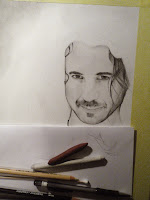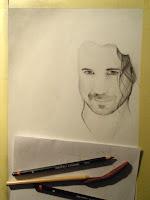Hello me hearties =)
So short before christmas I decided to finally take that big photo of all my materials I've got here and do a little material tutorial. Hope it's helpful for some of you. If you've got questions - feel free to leave a comment or write me, I will try to help as good as I can =)
So here we go:
1) My beloved Derwent Graphic pencils. Grades 9H to 9B.
About grades: pencil leads consist of a graphite + clay mixture. The more graphite, the softer the pencil and the darker the abrasion is. The more clay, the harder the pencil. From 6H on - in my eyes - you can use those pencils only for technical drawings.
2)
A 120 piece box of Faber Castell Polychromos.
I love them but haven't
found much use for them yet cause I still need to practise... (Btw if
you notice that glitch on the upper side of the 3 parts of the box...
this was Microsoft ICE's fault... :-/ haven't got them twice xD)
3) Acrylic colors. The big bottles are from Schmincke, the small ones from ALDI.
4)
Acrylics again. A collection of all sizes and kinds of tubes, most of
them aren't used anymore... ^_^° The bigger ones are from Schmincke, the
clear ones are from REWE I think and of the rest I don't know anymore
where I got them...
For Acrylics: They're a mixture of pigments and an acrylic polymer emulsion. The cheaper the paint, the less pigments are contained. Still you can buy cheap stuff as well, they're good for doing areas where the underground has to shine through.
Acrylics are water soluble - means you don't have to poison yourself with toxic solvents. There's also a lot of effect, thicking and thinning addition stuff for them out there so the possibilities with acrylics are endless.
5) Schmincke Watercolors.
6) Drawing tools... From top to bottom:
- Paper stomps in all sizes
For smudging in pencil drawings. They're good for details. If they get too dirty, use a nailfile and file the dirt off. If they're REALLY dirty, get a crapet knife and cut off the dirt.
- A mechanical pencil
They come in several grades, just as pencils themselves. They're awesome for doing details in beards and hair.
- Faber Castell Eraser pencils
Perfect for erasing small detais such as highlights on hair
- Different erasers, a grey one from Faber Castell, a white one and a kneaded eraser, also from Faber Castell
You can trim the grey erasers to sharp edges to erase light hair with it. The kneaded eraser is great for lighting up areas that got too dark or erase details such as stuff in hair.
- White gel pens
For highlights in eyes and metal pieces etc where you can't reach complete white with erasing-
- A jumbo 8B Faber Castell pencil
Love to use it for bigger black areas..
- A 9B graphite stick, also by Faber Castell
Usually just used by me to make graphite powder by sharpening it
7) Graphite powder in a small glass and pencil sharpener
Graphite powder is awesome. Dip a paintbrush into it and start painting with it or make a smooth background. You can make it yourself or buy it in art supply stores.
8) A big brush for big canvases and backgrounds and doctor's Q-tips for smudging in pencil drawings
I chose to get those Q-tips with the longer wooden stick because normal ones just weren't made for my chubby fingers..
9) Masking tape (cheap stuff from ALDI) to tape my future portraits 'n stuff.
Discovered that lately. I wanted to get straight edges and neat white frames on my pictures so I told my sister to bring me masking tape :D
10) Paintbrushes. A load of them. One can never have enough paintbrushes in my eyes x)
Not much to say here. Just so much - the white haired synthetic brushes are awesome for acrylics. I tend to use more synthetics these days cause normal paintbrushes are made of animal hair and I don't want any animal to die for my art.
11)
Fabriano Accademia paper.
The best stuff for portraits, really. The
blue labeled blocks are 120g/m² (56 lbs), the green ones 200g/m² (94
lbs). I recommend to not use the 120g/m² for things where you need
to get deep black spots because it gets wavy then. Better use the
thicker one.
12) Stabilo liners in several colors, silver gel
pens, blender pencils, a silver Faber Castell Pitt artist pen, a black
Edding marker, a Faber Castell broadpen in black, and a classical Online
fountain pen
For doing all kinds of stuff... details, writing, signing...
13) My beloved Canon CanoScan5600F scanner
Not much to say either, just: I love it and can highly recommend it. It has an incredible sharpness so I can even scan canvases with it. It comes with a scanning program where you can adjust just EVERYTHING.
14)
The chaos under my table... Art folders, more paper of all sorts, small
things such as corks, stickers, more paintbrushes, beads and all kinds
of stuff.
15) Glow-in-the-dark paint and Schmincke masking fluid
The glow paint can be mixed to a certain grade with white paint before it loses its ability to glow... For the masking fluid - always have an eye on it, the last bottle dried in due to unknown reasons... and never leave it on your paper for more than 2 days. Better not use it on canvases and any surface that sucks moisture in.
So... yeah ^^ All I know for now in short form. There will be an even more excessive tutorial on my upcoming web page =)
So far, have happy holidays and many presents beneath the sparkling tree =)
*vanishes*












